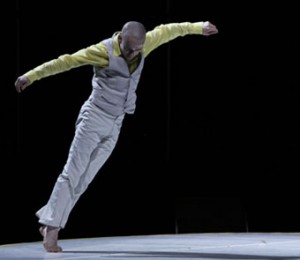 The PBS Arts Fall Festival reaches a high note with an inside look at how an artist creates a major dance and theater piece in honor of Abraham Lincoln’s bicentennial.
The PBS Arts Fall Festival reaches a high note with an inside look at how an artist creates a major dance and theater piece in honor of Abraham Lincoln’s bicentennial.
“Bill T. Jones: A Good Man” (PBS, 9 p.m., check local listings) follows the mercurial choreographer as he puts together the piece for the Ravinia Festival. First he has to sort out his own complicated thoughts about the 16th President.
With a brief bio of many of the creative types who surround Jones, the only thing missing at the end of the impressive film is eventually the work itself. But it’s a fascinating portrayal of the very demanding Jones, who told frightened critics at the press tour he’s really not that intimidating.
“Let’s put it this way,” he began slowly, with some command, “My work is an expression of my life and my feelings. People call it different things. When I was a young artist beginning, many, many people said that I had an identity problem because I was a white-dependent black man.
“I don’t mean to be a bit cantankerous,” he went on, “but one thing that, as an artist, you have to do, you have to roll with assumptions like that about who you are. Artists use everything at their disposal to make something come into the world. Now, is its purpose to intimidate? Is its purpose to – as this man says, to get people to think? Sometimes, maybe. I’m not quite sure. Art making is a spiritual activity for me. It’s trying to tell truth, and it’s trying to grapple with what is seen and unseen.”
Every time he makes a new work, Jones says, he must ask: “What is the reality of this event right now? The reality of it.”
And sometimes he shares that inquiry with his cast.
“Ask that little girl over there who just joined the company, who is 19, 20 years old: ‘Well, what do you think about this idea of Abraham Lincoln? Oh, you don’t know him? Oh, really? Well, okay.’
“I can get sarcastic with her, or I can say, ‘Okay. Well, let’s try to find out about Abraham Lincoln. What about women in his life? What about the fact that he had white supremacist ideas? And you, Bill T. Jones, what does it mean that you are in this room right now with — the majority of people in the room are white people. Look at this room, right? And who are you talking to?”
Jones was trying to imagine an audience too for the documentary that took two years to make, and how movement translates on television.
“Dance,” he says, “really does not want to be on a small screen. But therefore, I think this piece, because its talkiness and all those things is appropriate, because it has a lot of information that television does well.”
But live performance, he says to the reporters, “the distance between you and me, madam, is real right now. “
To illustrate, he unexpectedly screams.
“Now, put that on a little box, right? But this is what is so imprecious. The ancient Greeks knew it. We all know it. The live performance, how does that box enhance or interpret that? This is the question that, with directors, you have all the time.
“Fred Astaire used to say you never cut the body. You notice those films? They are always head to toe, and the image is 30 feet tall. Can you improve on that for dance?
“Television is a really challenging medium, and I think the talking and all that we do actually helps television appreciation.”
“Bill T. Jones: A Good Man” is presented as part of the “American Masters” series.